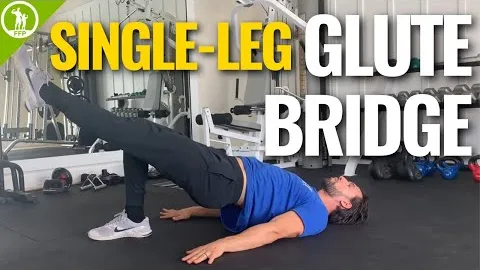Single-Leg Glute Bridge Exercise: Strengthen and Tone Your Glutes
If you're looking to strengthen and tone your glutes, incorporating the single-leg glute bridge exercise into your workout routine can be highly beneficial. This exercise is simple yet effective, targeting your gluteal muscles to give you a toned posterior. In addition to enhancing the appearance of your buttocks, strong glute muscles are important for maintaining good posture, improving athletic performance, and preventing lower back pain.
Benefits of the Single-Leg Glute Bridge
The single-leg glute bridge exercise offers numerous benefits for individuals of all fitness levels. Some of the key advantages of incorporating this exercise into your workout routine include:
- Glute Activation: The single-leg glute bridge specifically targets and activates your gluteal muscles, helping to strengthen and tone them effectively.
- Balance and Stability: By performing this exercise on just one leg, you engage your hip stabilizers and core muscles, improving your balance and stability.
- Reduced Back Pain: Strong glute muscles help to support the lower back and improve hip mobility, reducing the risk of lower back pain.
- Improved Athletic Performance: As the gluteal muscles are crucial for power and stability in movements such as running, jumping, and squatting, strengthening them through the single-leg glute bridge can enhance your athletic performance.
- Versatility: The single-leg glute bridge can be performed with little to no equipment, making it a convenient exercise that can be done at home or at the gym.
How to Perform the Single-Leg Glute Bridge
Follow these steps to perform the single-leg glute bridge exercise correctly:
- Starting Position: Lie on your back with your knees bent and feet flat on the floor. Place your hands by your sides for support.
- Lift One Leg: Extend one leg straight out, keeping it in line with your other thigh. Engage your core muscles to maintain stability throughout the movement.
- Bridge Up: Press through your heel on the floor and squeeze your glute muscles to lift your hips off the ground. Aim to form a straight line from your knee to your shoulder.
- Hold and Lower: Pause for a moment at the top of the movement and then slowly lower your hips back down to the starting position.
- Switch Legs: Repeat the exercise on the opposite leg. Aim to perform an equal number of repetitions on each leg to maintain balance and symmetry.
Tips and Modifications for the Single-Leg Glute Bridge
Consider the following tips and modifications to ensure you perform the single-leg glute bridge exercise correctly and safely:
- Focus on Form: Keep your core engaged and your glutes activated throughout the exercise. Avoid arching your lower back or letting your knee collapse inward.
- Gradual Progression: Start with a comfortable number of repetitions and gradually increase the intensity as your gluteal muscles become stronger.
- Equipment Variation: To increase the challenge, you can add resistance by placing a resistance band just above your knees or by using a stability ball under your feet.
- Alternatives: If the single-leg glute bridge feels too challenging initially, you can begin with the double-leg glute bridge, where both feet remain on the ground throughout the exercise.
- Breathing: Inhale as you lower your hips and exhale as you bridge up. Focusing on your breathing can help you maintain control and stability throughout the exercise.
Incorporating the Single-Leg Glute Bridge into Your Workout Routine
To maximize the benefits of the single-leg glute bridge exercise, consider incorporating it into your workout routine in the following ways:
- Warm-Up: Include the single-leg glute bridge exercise as part of your dynamic warm-up routine. This will activate your glute muscles and prepare them for the workout ahead.
- Strength Training: Perform 2-3 sets of 10-15 repetitions on each leg as part of your lower body or full-body strength training routine. Rest for 30-60 seconds between sets.
- Super Set: Pair the single-leg glute bridge with another lower body exercise, such as squats or lunges, to create a super set. This will challenge your glutes and overall lower body strength.
- Active Recovery: Incorporate the single-leg glute bridge into your active recovery routine on rest days. This exercise is gentle on your joints and can help enhance blood circulation and promote muscle recovery.
Conclusion
The single-leg glute bridge exercise is an effective way to strengthen and tone your gluteal muscles, improving both your physical appearance and overall functional strength. By incorporating this exercise into your workout routine, you can reap numerous benefits, including enhanced glute activation, improved balance and stability, reduced back pain, and improved athletic performance. So, why not give the single-leg glute bridge a try and feel the burn in your glutes today?
